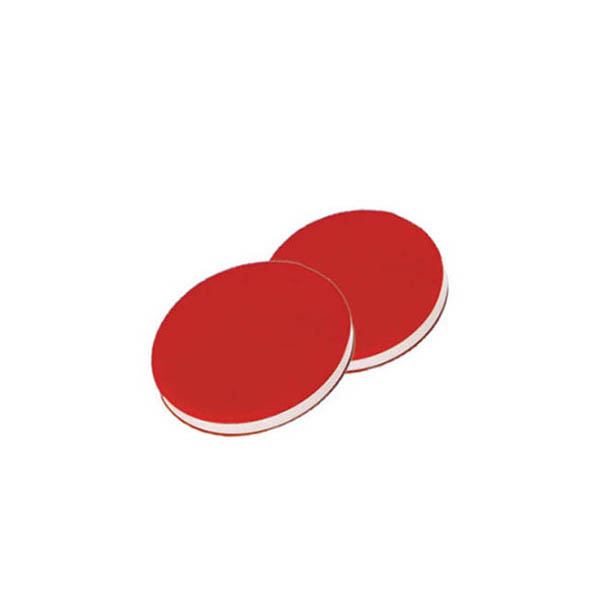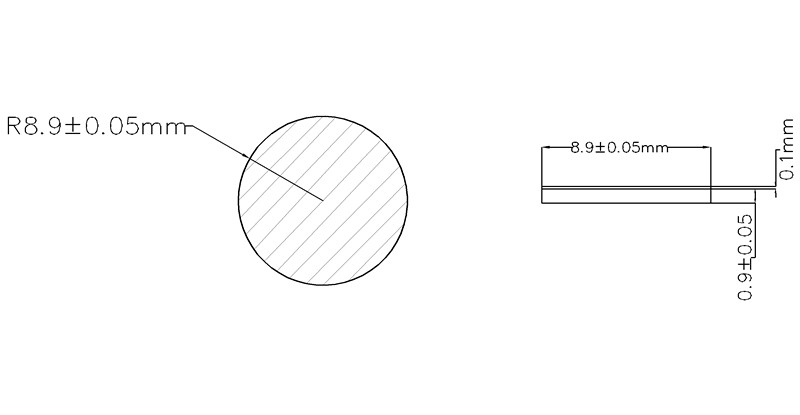Products List
Inquiry



Suit for: 9mm Short Thread Vial Caps
Septa Material: PTFE/Silicone or PTFE/Silicone/PTFE
Septa Feature: Non-preslit / I Preslit / X Preslit
Septa Size: 9mm*1mm
Color: White, Red, Blue
 PTFE/Silicone/PTFE Septa:
A layer of PTFE is laminated to each side of high purity, medium durometer silicone to form a septum that is the most resistant to coring while maintaining good resealing characteristics. The PTFE/Silicone/PTFE septum is recommended for the most critical applications such as ultra trace analysis or where there is a longer time between injections or for internal standard methods. PTFE/Silicone/PTFE septa provide superior performance with any autosampler employing a large diameter, blunt tip needle.
PTFE/Silicone/PTFE Septa:
A layer of PTFE is laminated to each side of high purity, medium durometer silicone to form a septum that is the most resistant to coring while maintaining good resealing characteristics. The PTFE/Silicone/PTFE septum is recommended for the most critical applications such as ultra trace analysis or where there is a longer time between injections or for internal standard methods. PTFE/Silicone/PTFE septa provide superior performance with any autosampler employing a large diameter, blunt tip needle.
| Septa Material | Advantages | Chemical Resistance | Applications | Max Temp |
| PTFE/silicone | Excellent resealing capabilities | Excellent until punctured Not suitable for chlorosilanes | Multiple injections than moderate resistance | 200°C |
| Pre-slit PTFE/silicone | Reduces coring Prevents vacuum from inside the vial | Excellent until punctured than moderate resistance | Multiple injections | 200°C |
| PTFE/silicone/ PTFE | Resistant to coring Autoclavable | Excellent | Above average resealing Multiple injections or applications with long periods between injections | 200°C |
 Pre-slit or Not
Chromatography septas can be pre-slit or not and must be considered by evaluating a few factors. A pre-slit septum is an ideal choice in applications requiring 20% or more of the sample injection each time from the vial so that suction is avoided.
The slit allows ambient gas to equalize the gas in the vial so that a vacuum is not created in the vial from the tight seal around the needle. If coring or clogging from a narrow needle or needle deflection from highly durable septa material is a concern, then choosing a pre-slit septum is a better choice.
The non-pre-slit septas help to reduce carryover from vial to vial because the resealing characteristics of the septum act as a squeegee to wipe solution from the outside of the needle. Typically, a non-slit septum exhibits resealing capabilities for a limited number of needle punctures but for long-term storage in the vial, using a new non-punctured septum is best practice.
A PTFE/Silicone with slitted septum allows for easier needle penetration as well as to release the vacuum that forms when a large volume of sample is withdrawn from a vial. This septum provides chromatographic characteristics similar to that of a septum without a slit except that the ability to withstand exposure to aggressive solvents is slightly lessened. Pre-slit septa are highly recommended improving injection to injection reproducibility with autosamplers withdrawing greater than 50µL of sample from a 2mL vial, due to possible cavitation (vacuum).
Pre-slit or Not
Chromatography septas can be pre-slit or not and must be considered by evaluating a few factors. A pre-slit septum is an ideal choice in applications requiring 20% or more of the sample injection each time from the vial so that suction is avoided.
The slit allows ambient gas to equalize the gas in the vial so that a vacuum is not created in the vial from the tight seal around the needle. If coring or clogging from a narrow needle or needle deflection from highly durable septa material is a concern, then choosing a pre-slit septum is a better choice.
The non-pre-slit septas help to reduce carryover from vial to vial because the resealing characteristics of the septum act as a squeegee to wipe solution from the outside of the needle. Typically, a non-slit septum exhibits resealing capabilities for a limited number of needle punctures but for long-term storage in the vial, using a new non-punctured septum is best practice.
A PTFE/Silicone with slitted septum allows for easier needle penetration as well as to release the vacuum that forms when a large volume of sample is withdrawn from a vial. This septum provides chromatographic characteristics similar to that of a septum without a slit except that the ability to withstand exposure to aggressive solvents is slightly lessened. Pre-slit septa are highly recommended improving injection to injection reproducibility with autosamplers withdrawing greater than 50µL of sample from a 2mL vial, due to possible cavitation (vacuum).
| Part No. | Description |
| S91 | White PTFE/Red Silicone Septa, Φ9*1mm |
| S92 | Red PTFE/White Silicone Septa, Φ9*1mm |
| S93 | Red PTFE/White Silicone/Red PTFE Septa, Φ9*1mm |
| S944 | I Pre-slit Blue PTFE/White Silicone Septa, Φ9*1mm |
| SX944 | X Pre-slit Blue PTFE/White Silicone Septa, Φ9*1mm |